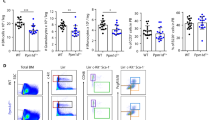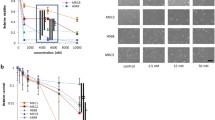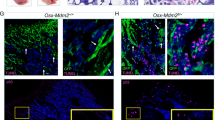Abstract
Anthracyclines, including doxorubicin, are widely used in the treatment of leukemia. While the effects of doxorubicin on hematopoietic cells have been characterized, less is known about the response of human mesenchymal stem cells (hMSCs) in the bone marrow stroma to anthracyclines. We characterized the effect of doxorubicin on key DNA damage responses in hMSCs, and compared doxorubicin sensitivity and DNA damage response activation between isolated hMSCs and the chronic myelogenous leukemia cell line, K562. Phosphorylation of H2AX, Chk1, and RPA2 was more strongly activated in K562 cells than in hMSCs, at equivalent doses of doxorubicin. hMSCs were relatively resistant to doxorubicin such that, following exposure to 15 μM doxorubicin, the level of cleaved caspase-3 detected by western blotting was lower in hMSCs compared to K562 cells. Flow cytometric analysis of cell cycle progression demonstrated that exposure to doxorubicin induced G2/M phase arrest in hMSCs, while 48 h after exposure, 15.6 % of cells were apoptotic, as determined from the percentage of cells having sub-G1 DNA content. We also show that the doxorubicin sensitivity of hMSCs isolated from a healthy donor was comparable to that of hMSCs isolated from a chronic lymphocytic leukemia patient. Overall, our results demonstrate that high doses of doxorubicin induce the DNA damage response in hMSCs, and that cultured hMSCs are relatively resistant to doxorubicin.



Similar content being viewed by others
Abbreviations
- hMSC:
-
Human mesenchymal stem cells
- DDR:
-
DNA damage response
- ATM:
-
Ataxia telangiectasia mutated
- ATR:
-
ATM- and Rad3-related
- DNA-PK:
-
DNA-dependent protein kinase
- Chk1:
-
Checkpoint kinase 1
References
Prockop DJ. Marrow stromal cells as stem cells for nonhematopoietic tissues. Science. 1997;276:71–4.
Conget PA, Minguell JJ. Phenotypical and functional properties of human bone marrow mesenchymal progenitor cells. J Cell Physiol. 1999;181:67–73.
Pittenger MF, Mackay AM, Beck SC, Jaiswal RK, Douglas R, Mosca JD, et al. Multilineage potential of adult human mesenchymal stem cells. Science. 1999;284:143–7.
Zhu J, Emerson SG. A new bone to pick: osteoblasts and the haematopoietic stem-cell niche. BioEssays. 2004;26:595–9.
Meuleman N, Tondreau T, Ahmad I, Kwan J, Crokaert F, Delforge A, et al. Infusion of mesenchymal stromal cells can aid hematopoietic recovery following allogeneic hematopoietic stem cell myeloablative transplant: a pilot study. Stem Cells Dev. 2009;18:1247–52.
Minotti G, Menna P, Salvatorelli E, Cairo G, Gianni L. Anthracyclines: molecular advances and pharmacologic developments in antitumor activity and cardiotoxicity. Pharmacol Rev. 2004;56:185–229.
Swift LP, Rephaeli A, Nudelman A, Phillips DR, Cutts SM. Doxorubicin-DNA adducts induce a non-topoisomerase II-mediated form of cell death. Cancer Res. 2006;66:4863–71.
Zhou BB, Elledge SJ. The DNA damage response: putting checkpoints in perspective. Nature. 2000;408:433–9.
Harper JW, Elledge SJ. The DNA damage response: ten years after. Mol Cell. 2007;28:739–45.
Durocher D, Jackson SP. DNA-PK, ATM and ATR as sensors of DNA damage: variations on a theme? Curr Opin Cell Biol. 2001;13:225–31.
Devine SM, Hoffman R. Role of mesenchymal stem cells in hematopoietic stem cell transplantation. Curr Opin Hematol. 2000;7:358–63.
da Silva Meirelles L, Caplan AI, Nardi NB. In search of the in vivo identity of mesenchymal stem cells. Stem Cells. 2008;26:2287–99.
Wang T, Xu Z, Jiang W, Ma A. Cell-to-cell contact induces mesenchymal stem cell to differentiate into cardiomyocyte and smooth muscle cell. Int J Cardiol. 2006;109:74–81.
Prendergast AM, Cruet-Hennequart S, Shaw G, Barry FP, Carty MP. Activation of DNA damage response pathways in human mesenchymal stem cells exposed to cisplatin or gamma-irradiation. Cell Cycle. 2011;10(21):3768–77.
Cruet-Hennequart S, Prendergast AM, Barry FP, Carty MP. Human mesenchymal stem cells (hMSCs) as targets of DNA damaging agents in cancer therapy. Curr Cancer Drug Targets. 2010;10:411–21.
Cruet-Hennequart S, Villalan S, Kaczmarczyk A, O’Meara E, Sokol AM, Carty MP. Characterization of the effects of cisplatin and carboplatin on cell cycle progression and DNA damage response activation in DNA polymerase eta-deficient human cells. Cell Cycle. 2009;8:3039–50.
Menendez D, Inga A, Resnick MA. The expanding universe of p53 targets. Nat Rev Cancer. 2009;9:724–37.
Yoshida K, Miki Y. The cell death machinery governed by the p53 tumor suppressor in response to DNA damage. Cancer Sci. 2010;101:831–5.
Dai Y, Grant S. New insights into checkpoint kinase 1 in the DNA damage response signaling network. Clin Cancer Res. 2010;16:376–83.
Mueller LP, Luetzkendorf J, Mueller T, Reichelt K, Simon H, Schmoll HJ. Presence of mesenchymal stem cells in human bone marrow after exposure to chemotherapy: evidence of resistance to apoptosis induction. Stem Cells. 2006;24:2753–65.
Wang D, Jang DJ. Protein kinase CK2 regulates cytoskeletal reorganization during ionizing radiation-induced senescence of human mesenchymal stem cells. Cancer Res. 2009;69:8200–7.
Law JC, Ritke MK, Yalowich JC, Leder GH, Ferrell RE. Mutational inactivation of the p53 gene in the human erythroid leukemic K562 cell line. Leuk Res. 1993;17:1045–50.
Iliakis G, Wang Y, Guan J, Wang H. DNA damage checkpoint control in cells exposed to ionizing radiation. Oncogene. 2003;22:5834–47.
Matsuura K, Wakasugi M, Yamashita K, Matsunaga T. Cleavage-mediated Activation of Chk1 during Apoptosis. J Biol Chem. 2008;283:25485–91.
Leung-Pineda V, Huh J, Piwnica-Worms H. DDB1 targets Chk1 to the Cul4 E3 ligase complex in normal cycling cells and in cells experiencing replication stress. Cancer Res. 2009;69:2630–7.
Zhang YW, Otterness DM, Chiang GG, Xie W, Liu YC, Mercurio F, et al. Genotoxic stress targets human Chk1 for degradation by the ubiquitin-proteasome pathway. Mol Cell. 2005;19:607–18.
Kurz EU, Douglas P, Lees-Miller SP. Doxorubicin Activates ATM-dependent Phosphorylation of Multiple Downstream Targets in Part through the Generation of Reactive Oxygen Species. J Biol Chem. 2004;279:53272–81.
Rogakou EP, Pilch DR, Orr AH, Ivanova VS, Bonner WM. DNA double-stranded breaks induce histone H2AX phosphorylation on serine 139. J Biol Chem. 1998;273:5858–68.
Oakley GG, Patrick SM. Replication protein A: directing traffic at the intersection of replication and repair. Front Biosci. 2010;15:883–900.
Kim HS, Lee YS, Kim DK. Doxorubicin exerts cytotoxic effects through cell cycle arrest and Fas-mediated cell death. Pharmacology. 2009;84:300–9.
Jager M, Schultheis A, Westhoff B, Krauspe R. Osteogenic progenitor cell potency after high-dose chemotherapy (COSS-96). Anticancer Res. 2005;25:947–54.
de Lima Prata K, Orellana MD, De Santis GC, Kashima S, Fontes AM, de Cássia Viu Carrara R et al. Effects of high-dose chemotherapy on bone marrow multipotent mesenchymal stromal cells isolated from lymphoma patients. Exp Hematol. 2010;38:292–300.e4.
Matushansky I, Hernando E, Socci ND, Mills JE, Matos TA, Edgar MA, et al. Derivation of sarcomas from mesenchymal stem cells via inactivation of the Wnt pathway. J Clin Invest. 2007;117:3248–57.
Ito K, Hirao A, Arai F, Matsuoka S, Takubo K, Hamaguchi I, et al. Regulation of oxidative stress by ATM is required for self-renewal of haematopoietic stem cells. Nature. 2004;431:997–1002.
Rossi DJ, Seita J, Czechowicz A, Bhattacharya D, Bryder D, Weissman IL. Hematopoietic stem cell quiescence attenuates DNA damage response and permits DNA damage accumulation during aging. Cell Cycle. 2007;6:2371–6.
Barta T, Vinarsky V, Holubcova Z, Dolezalova D, Verner J, Pospisilova S, et al. Human embryonic stem cells are capable of executing G1/S checkpoint activation. Stem Cells. 2010;28:1143–52.
Momcilovic O, Choi S, Varum S, Bakkenist C, Schatten G, Navara C. Ionizing radiation induces ataxia telangiectasia mutated-dependent checkpoint signaling and G(2) but not G(1) cell cycle arrest in pluripotent human embryonic stem cells. Stem Cells. 2009;27:1822–35.
Quante M, Tu SP, Tomita H, Gonda T, Wang SS, Takashi S, et al. Bone marrow-derived myofibroblasts contribute to the mesenchymal stem cell niche and promote tumor growth. Cancer Cell. 2011;19:257–72.
Roodhart JM, Daenen LG, Stigter EC, Prins HJ, Gerrits J, Houthuijzen JM, et al. Mesenchymal stem cells induce resistance to chemotherapy through the release of platinum-induced fatty acids. Cancer Cell. 2011;20:370–83.
Acknowledgments
This research was supported by grants from the Health Research Board (HRB grant number RP-2008-217) and from the Children’s Leukaemia Research Project. The Regenerative Medicine Institute, NUI Galway, is supported by funding from Science Foundation Ireland. AMP was supported in part by Galway County Council, and by the Thomas Crawford Hayes Fund, NUI Galway. We are grateful to Dr. Mark R.E. Coyne for providing patient-derived hMSCs, and to Dr. Eva Szegezdi for providing K562 cells.
Conflict of interest
The author(s) declare that they have no competing interests.
Author information
Authors and Affiliations
Corresponding author
Electronic supplementary material
Below is the link to the electronic supplementary material.
12185_2012_1196_MOESM1_ESM.pdf
Supplementary Figure 1: DNA damage responses and apoptosis induction in K562 cells treated with 1 μM doxorubicin. A. K562 cells were treated with 1 μM doxorubicin for the indicated times. DNA damage response proteins were analyzed by western blotting, as described in the legend to Fig. 1, and in Materials and Methods. B. Flow cytometry histograms from a representative experiment, showing the induction of sub-G1 cells, 48 h after mock-treatment or treatment of K562 cells with 1 μM doxorubicin. C. The percentage of sub-G1 K562 cells was determined following propidium iodide staining and flow cytometry, 48 h after treatment. Data represent the mean of two independent experiments; error bars represent one standard deviation (PDF 125 kb)
About this article
Cite this article
Cruet-Hennequart, S., Prendergast, Á.M., Shaw, G. et al. Doxorubicin induces the DNA damage response in cultured human mesenchymal stem cells. Int J Hematol 96, 649–656 (2012). https://doi.org/10.1007/s12185-012-1196-5
Received:
Revised:
Accepted:
Published:
Issue Date:
DOI: https://doi.org/10.1007/s12185-012-1196-5




